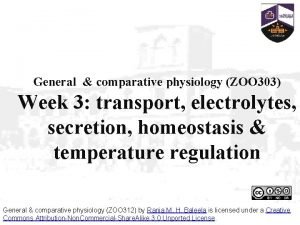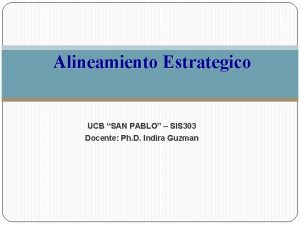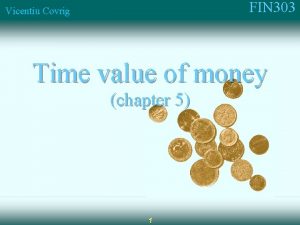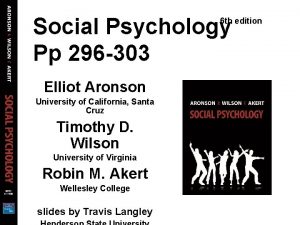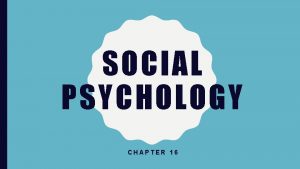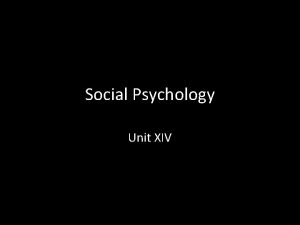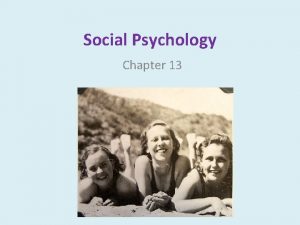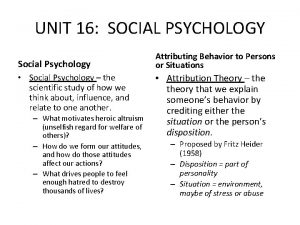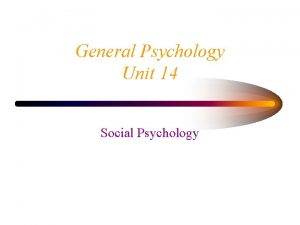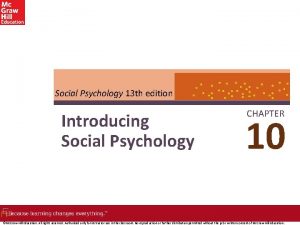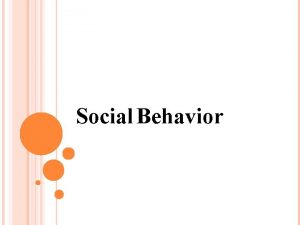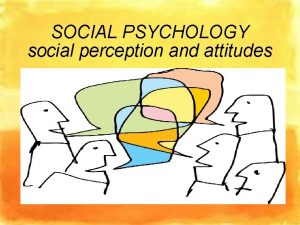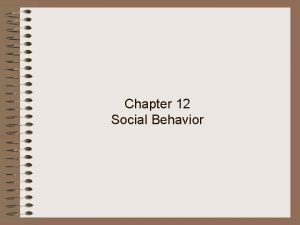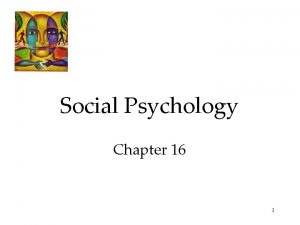Social Psychology Pp 296 303 6 th edition
























- Slides: 24

Social Psychology Pp 296 -303 6 th edition Elliot Aronson University of California, Santa Cruz Timothy D. Wilson University of Virginia Robin M. Akert Wellesley College slides by Travis Langley

Cooperation A form of pro-social behavior where people work together with commonly agreed-upon goals instead of working separately in competition.

Cooperative Group Traits • Effective communication- members of the group feel free to voice their opinions and know they are being heard by others • Group members help other members • There is a division of labor and a clear setting of group goals • There is a basic similarity in beliefs and values • Everyone’s needs are valid and worth addressing

Factors Affecting Cooperation • Social Norms (Bicchieri, 2006)- requires a belief that others conform to the norm (ie, littering) and that a sufficient number of others expect the person to conform • Group Size- cooperation decreases in larger groups • Culture- collectivistic cultures increase one’s willingness to cooperate (Gabrenya et al, 1985)

Inter-Group Conflict • People often have incompatible goals, placing them in conflict with each other • This can be true of individuals, groups, companies, nations • Conflict occurs when what one groups wants, another group perceives as harmful to its interests

Social Dilemmas Social Dilemma A conflict in which the most beneficial action for an individual will, if chosen by most people, have harmful effects on everyone.

Social Dilemmas Prisoner’s dilemma: In this game, two people have to choose one of two options without knowing what the other person will choose. Your payoff (the amount of money you win or lose) depends on the choices of both you and your friend. For instance, if both you and your friend choose option X, you both win $3. If, however, you choose option Y and your friend chooses option X, you win $6 and your friend loses $6.

Increasing Cooperation in the Prisoner’s Dilemma People are more likely to adopt a cooperative strategy that maximizes both their profits and their partner’s if: • Playing the game with a friend, or • They expect to interact with their partner in the future.

Increasing Cooperation in the Prisoner’s Dilemma • Growing up in some societies, such as Asian cultures, seems to foster a more cooperative orientation. • Changing the name of the game from the “Wall Street Game” to the “Community Game” increased the percentage of people who cooperated from 33% to 71% in one study.

Increasing Cooperation in the Prisoner’s Dilemma Tit-for-Tat Strategy A means of encouraging cooperation by at first acting cooperatively but then always responding the way your opponent did (cooperatively or competitively) on the previous trial.

Other Kinds of Social Dilemmas Public Goods Dilemma A social dilemma in which individuals must contribute to a common pool in order to maintain the public good. Commons Dilemma A social dilemma in which everyone takes from a common pool of goods that will replenish itself if used in moderation but will disappear if overused.

Realistic Group Conflict Theory Campbell’s (1965) realistic group conflict theory (RGCT), also known as realistic conflict theory (RCT), states that inter-group conflict can arise when groups have opposing goals and are competing for limited resources. RGCT also states that when groups are pursuing a mutual goal and success requires cooperation, prejudice and conflict is reduced

The Robber’s Cave Studies • Muzafer Sherif and his colleagues conducted three famous field experiments known as the Robber’s Cave or Summer Camp studies (1954, 1958, 1961) in order to demonstrate RGCT, the role of competition in conflict and how to resolve conflict • See study summary

Conflict Resolution

The Contact Hypothesis The most well-known and simplest theory to reduce conflict was provided by Allport (1954) which states: The best way to reduce conflict between groups is to bring them into contact with each other

The Contact Hypothesis This is easier said than done and there are many examples where placing rival groups into contact with each other has produced even more hostility. Allport claimed a number of conditions needs to be satisfied if contact was to reduce conflict…

The Contact Hypothesis (See Oxford, Pp 402 -403) • Social and institutional support • High acquaintance potential • Equal status between groups • Cooperation

Using Threats to Resolve Conflict A classic series of studies by Morton Deutsch and Robert Krauss (1960, 1962) indicates that threats are not an effective means of reducing conflict. They had two participants at a time imagine they each controlled a truck company (Acme and Bolt) and needed to transport merchandise using the most direct (shortest) route to maximize profit; however, each route was slowed down by the other’s use of the same one-lane road.

After a while, most of them worked out a solution that allowed both trucks to make a modest amount of money. They took turns crossing the one-lane road.

Negotiation and Bargaining Negotiation A form of communication between opposing sides in a conflict in which offers and counteroffers are made and a solution occurs only when both parties agree. Integrative Solution A solution to conflict whereby parties make trade-offs on issues according to their different interests; each side concedes the most on issues that are unimportant to it but important to the other side.

The bottom line? When negotiating with someone, keep in mind that integrative solutions are often available. Try to gain the other side’s trust, and communicate your own interests in an open manner. Remember that the way you construe the situation is not necessarily the same as the way the other party construes the situation. You may well discover the other side communicates its interests more freely as a result, increasing the likelihood that you will find a solution beneficial to both parties.

The Jigsaw Classroom To reduce conflict in a classroom, Aronson (1978) developed a technique modeled after the Cave Robbers studies: • Students were placed in diverse 6 -person learning groups • Each student was responsible for learning and teaching 1/6 of the material to each person in the group • Only until the parts were put together (like a jigsaw puzzle) could the students fully understand the material

The Jigsaw Classroom • Rates of bullying in school were reduced as well as a decrease in prejudice and stereotyping • Positive interactions between groups increased as did students’ liking for their groupmates both within and across ethnic boundaries • Cooperative learning has emerged as an effective way to improve race relations and improve instruction

The End
 Social psychology ninth edition
Social psychology ninth edition Ap psychology social trap
Ap psychology social trap Fundamental attribution error ap psychology
Fundamental attribution error ap psychology Social psychology is the scientific study of:
Social psychology is the scientific study of: 38cfr3.303
38cfr3.303 Vir 303
Vir 303 Comp 303
Comp 303 Ruger no 1 accuracy improvement
Ruger no 1 accuracy improvement Zoo 303
Zoo 303 Sis-303
Sis-303 Fin 303
Fin 303 Kravis theory of availability
Kravis theory of availability Eco 303
Eco 303 Dywizjon 303 klp
Dywizjon 303 klp 3 6 9 12 15 18 21 24 27 30 33 36
3 6 9 12 15 18 21 24 27 30 33 36 Life orientation grade 7 term 2 activities
Life orientation grade 7 term 2 activities Form uib-290
Form uib-290 Coloradoui.gov/myuiemployer
Coloradoui.gov/myuiemployer Mktg 303
Mktg 303 Bilişi yönetme
Bilişi yönetme Cse 303
Cse 303 Wac 296-155-305
Wac 296-155-305 Wac 296-800-160
Wac 296-800-160 Wac 296 305
Wac 296 305 Nnpj-296
Nnpj-296








